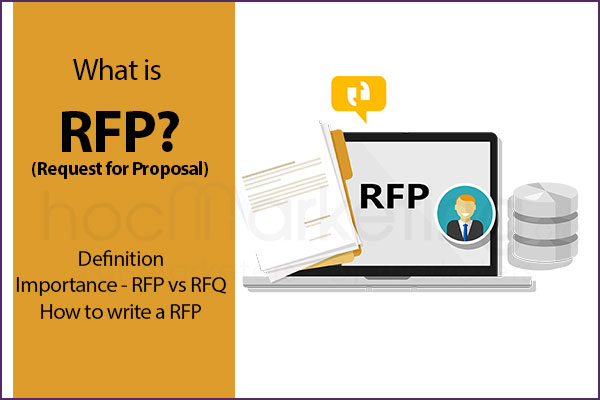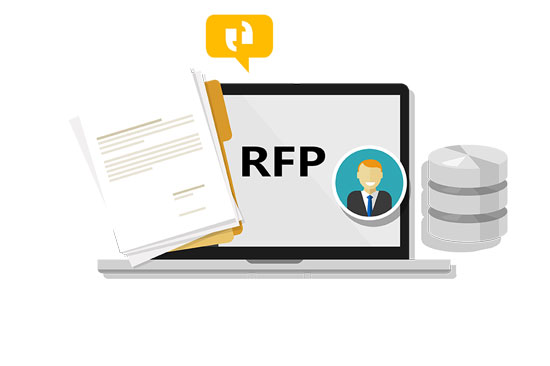
What is RFP? Why are RFPs important? How to create a RFP

RFP (Request for Proposal) is one of the great tools for businesses to implement large projects that need contributions from 3rd parties. In this article, we will go to understand what RFP is, its importance and how to build a standard RFP.
RFP (Request for Proposal) is one of the great tools for businesses to implement large projects that need contributions from 3rd parties. Besides fields such as construction, production, commerce .. RFP is also widely used in Marketing activities such as product development, promotion and distribution...In this article, we will go to understand what RFP is, its importance and how to build a standard RFP.
What is RFP?
RFP stands for Request for Proposal. It is a specialized document type used in business activities that lists the necessary requirements (quantity of personnel, professional qualifications). , implementation time...) for contractors, agencies, individuals... when participating in a project or program of an enterprise.
Roughly speaking, RFP is similar to job description in recruitment. If your business has a project that needs the cooperation of a 3rd party, your business can write an RFP to clearly state the requirements and necessary content that the 3rd party must understand and meet the standards to participate in. family.
In Marketing, RFP is used in cases where businesses need to screen third parties to participate in Marketing campaigns, sales support activities, distribution, and promotion.
Short history of RFPs
RFPs were created around the 1970's when companies began outsourcing large projects. It became a way for the company to outline what they needed done, while allowing multiple vendors to submit their information which allowed them to compare prices and services.
Nowadays, RFPs are used in many industries. Not just for marketing campaigns or large projects, but also for general requirements such as office supplies and products.
Why are RFPs important?
1. RFP helps businesses screen qualified partners to implement projects.
When businesses deploy a large-scale, complex project and need to outsource, building an RFP is extremely necessary. On the one hand, RFP helps partners understand the requirements of the business, as well as supports the screening of qualified partners. On the other hand, RFP helps businesses clearly define the criteria they need to be able to effectively and successfully implement projects.
2. RFP helps maintain consistency in projects from one partner to another.
Not always a project has only 1 partner involved. Sometimes a project will involve 2 or more partners, with different roles. If there is no consistency and methodical in the implementation process, mistakes are very easy to happen. Therefore, the appearance of RFP is extremely necessary in this case. RFP helps partners clearly define the goals to be achieved, production standards, deadlines... of the project so that they can coordinate smoothly and effectively.
For example:
- A real estate project needs the participation of contractors for items such as: design, construction, management and operation, promotion...
- A communication & promotion project needs the participation of third parties for the following categories: campaign design, content development, media platform providers...
3. RFP helps partners understand the project.
Thanks to the information shown on the RFP, partners can know about the project in a short time, thereby helping businesses save time and improve efficiency in project dissemination.
4. RFP helps maintain good relationship with partners.
Helping 3rd parties understand the requirements of a judge will help them save time and effort as well as improve work efficiency. From there, businesses can have the opportunity to maintain good relationships with partners - an abundant resource for future projects of the business.
Differences between RFP(Request for Proposal) and RFQ (Request for Quotation)
RFQ - (Request for Quotation) is a concept that is easily confused with RFP. To avoid confusion, we should understand the difference between these two concepts:
| RFP | RFQ |
| RFP stands for Request for Proposal | RFQ stands for Request for Quotation |
| RFP is used in cases where businesses need to screen partners to participate in a specific project. | RFQs are often used when businesses want to ask these partners to provide quotes for specific products/services. |
| RFPs are often geared towards finding highly qualified partners. | RFQ aims to find partners who provide new products/services at the best price |
How to create a standard RFP
In order for the partners to understand the project and the requirements of the business, an RFP should show the following contents:
1. Project overview
The project overview section provides information such as genre, size, location, target customers, product characteristics, distribution channels... so that readers have an overview. , comprehensive about the project.
2. The company background
It is important for agencies or freelancers to know who they are going to work for. The background section should include information about the company, such as size, location, number of employees and history.
3. Project requirements
In this section, RFP will provide readers with technical parameters to be achieved when implementing a project such as design standards, product structure, durability, stability, performance, operating capacity.. Each RFP will list different criteria on a case by case basis.
This is considered the main item of the RFP, when the partners will rely on these standards to compare with their own capabilities, thereby making a decision whether to participate in the project or not.
4. Project deadline and milestones
This section will show a freelancer or agency how quickly the company needs the project completed. It should also include information on when and what specific deliverables are expected at each milestone along the way.
Information about the timelines, the deadlines set and extremely necessary for any RFP. The shorter the deadlines given, the higher the performance capacity of the partners will be and vice versa. Therefore, businesses need to consider when setting deadlines to balance the problem between cost, productivity and efficiency.
5. Possible roadblocks
This section of the RFP will outline any possible problems that may arise in the project. These difficulties can come from external factors such as changes in macro factors (environment, weather, epidemics, government...) to internal factors such as (change in orientation). , human resources, technology...).
6. Project budget
This section outlines the company's budget for this project. Depending on the total cost, they may opt to work with a freelancer or agency who has experience in similar projects. However if it is too expensive, the client may prefer to go with an agency that will be able to complete the project at an affordable rate (for example).
7. Company expectations
This section will outline what the company expects from the freelancer or agency they hire. It should include how quickly they expect to receive proposals, their communication style and whether or not revisions/additional phases of work are included in the budget.
8. Appendix
The appendix section can include any additional information that may be useful to freelancers or agencies who are deciding whether or not they want to apply for this project (client testimonials, case studies, etc.).
9. Contact information
This section should help freelancers and agencies know how to contact the company when they want to apply. Phone numbers and email addresses should be the ones of a peson or department which is responsible for outsourcing. In addition, an online submission form should also be included with a link to the company's RFP.
Conclusion
RFPs are a great way to find qualified agencies or freelancers for your projects. In addition to providing project information to partners, RFP also helps the cooperation process become more seamless, close and effective, thereby helping to maintain a good relationship between businesses and units. this taste. A qualified RFP should include the following sections: Project overview, The company background, Project requirements, Project deadlines & milestones, Possible roadblocks, Project budget, Company Expectations, Appendix, Contact Information.
Hope this article has brought you useful information and knowledge!













